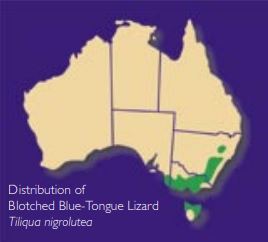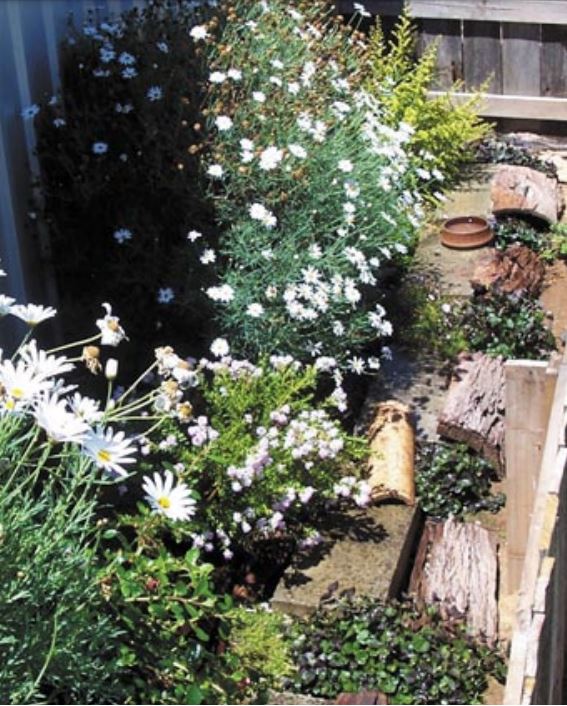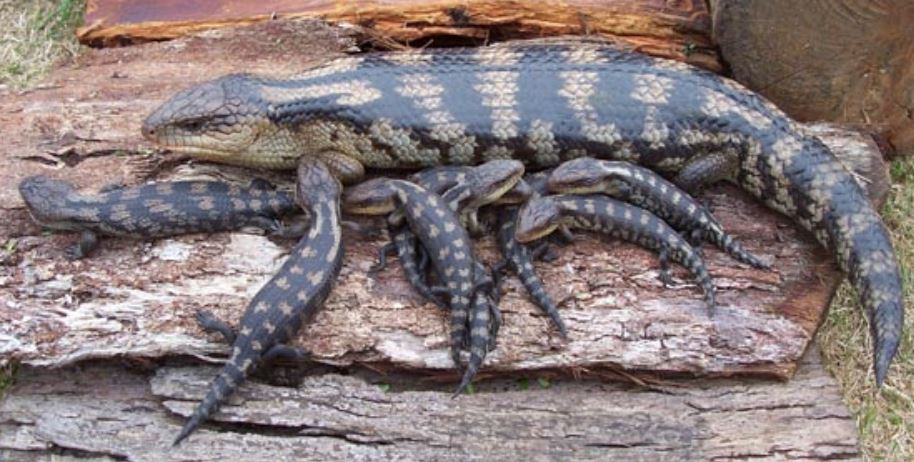Our experiences with blotched blue tongue lizards demonstrate very clearly how well suited to outdoor enclosures these lizards are.
Their large size, longevity, willingness to breed and ease of maintenance make them ideal for novice reptile keepers (especially children) to gain competence and experience in reptile husbandry
This study of keeping blotched blue tongue lizards (Tiliqua Nigrolutea) represents the knowledge and experience of Michael and Jacqui Throw, with photography from Michael Throw.
Introduction
Blotched blue tongued lizards Tiliqua nigrolutea are truly cool climate
lizards being widespread in Tasmania (including the larger Bass Strait islands) as well as cooler, higher rainfall districts in south eastern South Australia, southern Victoria and mountain habitats in New South Wales.

Within Tasmania blotched blue tongues are common and widespread, occurring in most habitat types from coastal heath to highland forests. They are very familiar to the general public because of their abundance around towns and cities throughout the State.
This article outlines our successful strategies at keeping and breeding this species outdoors at Ulverstone in northern Tasmania.
Our breeding adults have all been wild caught or were injured animals removed from hostile urban situations (eg. dog attacks).
They are maintained in outdoor enclosures of various shapes and sizes, for the most part dictated by the shape of our block and the absolutely essential requirement of 7-8 hours of sunlight during the summer months.
As with all captive reptiles, thermoregulation is the most important consideration in positioning of outdoor enclosures and should reflect, as closely as possible, the natural activity patterns of the reptiles involved.
Failure to achieve this will result in poor feeding, stunted development, and a lack of reproduction or the failure of embryos to develop properly in gravid females.
This is particularly important for large, sun loving species like T. nigrolutea that will forage in the midday sun in mid-summer (in Tasmania) when most self respecting reptiles have retired to shady retreats.
We have captured blotched blue tongue specimens in the wild with body temperatures as high as 36°C.
Housing
Our enclosures are essentially a sturdy wooden frame with short lengths of recycled wooden fence palings nailed to it to form a wall from just below ground level to a height of 60cm.
Our smallest enclosure is approximately 1.5 m square and the largest is 6 x 1m.

The enclosures have small shrubs and low ground cover plants planted in them as well as plenty of cover in the form of rocks and curved slabs of thick eucalypt bark.
Such varied ground cover is essential in providing a range of micro-habitats with varying temperature regimes that allow the lizards to precisely
maintain their preferred body temperature simply by moving from site to site within the enclosure during the course of the day.
Over winter, dens are plastic bins loosely filled with dry grass with entrance holes cut into the sides.
These are hidden from view behind vegetation and slabs of bark.
Heavy, earthenware water bowls are present in each enclosure and water
is changed regularly.
Reproduction & Breeding Behaviour
We house both blotched blue tongue sexes together all year round but no more than one adult male is present in a single enclosure during the courtship and mating period from October through to the end of November.
This is because sexually active males will savagely attack one another for access to females.
Attacks may include biting around the rival’s head or attempting to damage or remove limbs by biting them firmly and spinning around crocodile fashion.
Our breeding blotched blue tongue males are rotated around the enclosures weekly during the breeding season to increase our chances of reproductive success.
Mating is a somewhat violent affair with many people including some novice reptile keepers, misinterpreting it for fighting.
Male blue tongues grasp the female’s body tightly in their jaws just behind the front legs and can remain attached in this way for hours at a time.
If receptive, the female blue tongue will raise her tail off the ground to allow copulation to occur.
Males routinely break the females skin while holding on with their teeth and older females can often be seen in the wild with considerable scar tissue on their backs just behind the front legs from numerous matings during their lives.
Such scar tissue can be a very reliable indicator of sex when collecting these lizards.
Male blotched blue tongues are generally shorter and lighter than females with relatively larger heads and front legs.
Gestation in gravid females takes place over a a 4-5 month period with births in our collection taking place from mid-February to late March.
Our clutch sizes have ranged from one to ten and are directly related to the size of the female with our largest specimens (435mm, 640g) giving birth to the largest clutches.
Rearing Young
Because blotched blue tongue neonates are born in or close to autumn and the onset of cold, wet weather, we keep them indoors in heated cages for the first 5-6 months and return them into the outdoor enclosures the following spring.
Indoors, the neonates are maintained in glass fronted melamine cages 40x30x30cm in dimension and heated with a single 25 watt globe set on a timer.
The temperature gradient ranges from 25°C at the warm end to 18°C at the cool end.
Growth over the first 6 months is rapid with neonates ranging from 125-150mm and 13-17g at birth to around 300mm and 170g when taken back outside to the enclosures.
In five years breeding the same blotched blue tongue adults, we have found that generally, females will only reproduce every second year with only one female reproducing in consecutive years with the second clutch being half the size of the first one. (numbers in each clutch??)
There does not appear to be any reliable data on growth rates of blotched blue tongues in the wild or their size at sexual maturity but captive bred specimens in our collection have reproduced at one year of age.
One female gave birth to a single baby when only 302mm in total length and weighing 178g.
This indicates that wild specimens probably reproduce in their second or third year.
Dietary
One of the factors that makes blotched blue tongues (and all blue tongue species in general) so popular with reptile keepers and especially children, is their very catholic omnivorous diet.
Blotched blue tongue lizards will eat almost anything we do, from fruit and vegetables to fungi and meat.
While the docility of these lizards is legendary, most people do not realise that in the wild they can be savage predators, attacking a range of small animals from nestling birds and juvenile rodents to animals as large as leverets (baby hares), 120mm in length (Spencer, 2004).
We have found the best results are obtained by offering these lizards an approximately 50/50 diet of protein and vegetable matter.
Early in the season when our lizards first emerge from winter torpor (August/September) they are fed once a week but with increasing day length and warmth into summer, feeding is increased to every two days.
Meals are alternated between protein (pinky mice and rats, snails or tinned dog food) and fruit (eg. banana, strawberries) and simply offered on a flat tray placed in the enclosure.
Neonates are fed pinky mice for their first couple of feeds to give them a good head start with alternating protein and fruit meals from then on in exactly the same way as for our adults.
Frequent Questions About Blue Tongue Lizards
For completeness, below you will find some of the common questions about blotched blue tongue lizards and keeping them as pets. Most of these questions and answers are applicable to blue tongue lizards in general.
Are blue tongue lizards dangerous?
Blue-tongue lizards are not venomous, and although they can and do bite their teeth are used more for crushing rather than tearing. If you are bitten, such as on your finger, it is unlikely they will break the skin or cause real harm. They can, however, be quite persistent and refuse to release their bite.
How to tell the age of a blue tongue lizard
Telling the age of any lizard can be difficult due to many variables. Two lizards born on the same day may grow at vastly different rates. Some may grow to full size within 6 months, whereas others can take 2 years.
Quite often a blotched blue tongue lizard will be born between 15 to 20cm, and have been known to grow as much as 70cm.
How to tell the sex of a blue tongue lizard
Telling the sex of any blue tongue lizard may also be difficult. A male blue tongue will usually have a more triangular-shaped head, thicker tail, and often thinner sides than a female. Eye colour for male blue tongues is usually more orange and brighter than the brown eyes common with females.
It is common to confuse a larger female, especially those with greater fat storage within their tales, with a male blue tongue. Quite often people buy a blue tongue believing it is male, and accordingly find themselves frustrated when trying to breed.
Behaviour can offer a good indicator, especially when the blue tongue is placed with a known female. If the lizard of unknown sex begins to chase and mount the female then you very likely have a male!
For more accurate sexing it is possible to check for sperm plugs of a male, also known as a mating plug, copulation plug, or seminal plug. These plugs consist of coagulated semen which would be deposited into the genital tract of the female after mating.
During the process of excretion the eversion of hemipenes is a clear indication of a male. Hemipenes are a pair of intromittent organs common with male lizards, usually inverted, will at the time of excretion become everted. If you consider the human penis enlarging and retracting this is a similar example.
How often do blue tongue lizards eat?
As a general rule, feed your blue tongue lizard every other day during warmer weather. In colder whether they will be less active and will only need to be fed once every three days.
References
Spencer, C. P. (2004). Bluetongue attacks hare. The Tasmanian Naturalist 126. 18-19.
If you have further questions about botched blue tongue lizards then you may leave a message in the comments section below.

